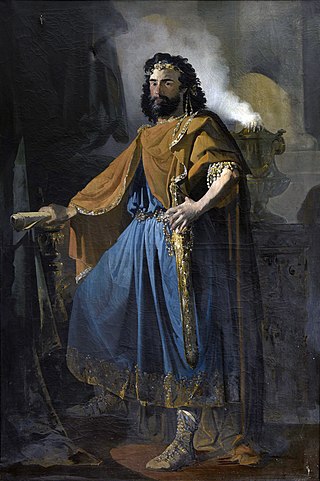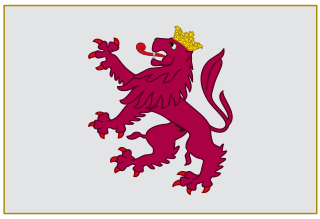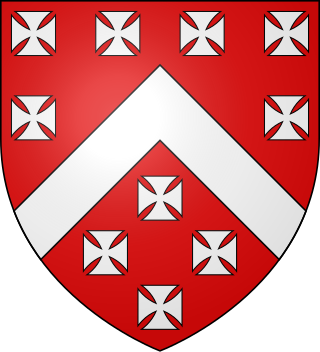
Euric, also known as Evaric, son of Theodoric I, ruled as king (rex) of the Visigoths, after murdering his brother, Theodoric II, from 466 until his death in 484. Sometimes he is called Euric II.

The Kingdom of León was an independent kingdom situated in the northwest region of the Iberian Peninsula. It was founded in 910 when the Christian princes of Asturias along the northern coast of the peninsula shifted their capital from Oviedo to the city of León. The kings of León fought civil wars, wars against neighbouring kingdoms, and campaigns to repel invasions by both the Moors and the Vikings, all in order to protect their kingdom's changing fortunes.

In Greco-Roman geography, Iberia was an exonym for the Georgian kingdom of Kartli, known after its core province, which during Classical Antiquity and the Early Middle Ages was a significant monarchy in the Caucasus, either as an independent state or as a dependent of larger empires, notably the Sassanid and Roman empires. Iberia, centered on present-day Eastern Georgia, was bordered by Colchis in the west, Caucasian Albania in the east and Armenia in the south.

The title Baron Berkeley originated as a feudal title and was subsequently created twice in the Peerage of England by writ. It was first granted by writ to Thomas de Berkeley, 1st Baron Berkeley (1245–1321), 6th feudal Baron Berkeley, in 1295, but the title of that creation became extinct at the death of his great-great-grandson, the fifth Baron by writ, when no male heirs to the barony by writ remained, although the feudal barony continued. The next creation by writ was in 1421, for the last baron's nephew and heir James Berkeley. His son and successor William was created Viscount Berkeley in 1481, Earl of Nottingham in 1483, and Marquess of Berkeley in 1488. He had no surviving male issue, so the Marquessate and his other non-inherited titles became extinct on his death in 1491, whilst the barony passed de jure to his younger brother Maurice. However, William had disinherited Maurice because he considered him to have brought shame on the noble House of Berkeley by marrying beneath his status to Isabel, daughter of Philip Mead of Wraxhall, an Alderman and Mayor of Bristol. Instead, he bequeathed the castle, lands and lordships comprising the Barony of Berkeley to King Henry VII and his heirs male, failing which to descend to William's own rightful heirs. Thus on the death of King Edward VI in 1553, Henry VII's unmarried grandson, the Berkeley inheritance returned to the family. Therefore, Maurice and his descendants from 1492 to 1553 were de jure barons only, until the return of the title to the senior heir Henry, becoming de facto 7th Baron in 1553. Upon his death he was succeeded by his relative George Harding.

The Kingdom of the Iberians was a medieval Georgian monarchy under the Bagrationi dynasty which emerged circa 888 AD, succeeding the Principality of Iberia, in historical region of Tao-Klarjeti, or upper Iberia in north-eastern Turkey as well parts of modern southwestern Georgia, that stretched from the Iberian gates in the south and to the Lesser Caucasus in the north.

Lucy Pevensie is a fictional character in C. S. Lewis's The Chronicles of Narnia series. She is the youngest of the four Pevensie children, and the first to find the Wardrobe entrance to Narnia in The Lion, the Witch and the Wardrobe. Of all the Pevensie children, Lucy is the closest to Aslan. Also, of all the humans who have visited Narnia, Lucy is perhaps the one that believes in Narnia the most. She is ultimately crowned Queen Lucy the Valiant, co-ruler of Narnia along with her two brothers and her sister. Lucy is the central character of the four siblings in the novels. Lucy is a principal character in three of the seven books, and a minor character in two others.

Saint Nino was a woman who preached Christianity in the territory of the Kingdom of Iberia, in what is modern-day Georgia. Her preaching resulted in the Christianization of Iberia.

Vakhtang I Gorgasali, of the Chosroid dynasty, was a king (mepe) of Iberia, natively known as Kartli in the second half of the 5th and first quarter of the 6th century.

Pkhovi, also known as Pkhoeti (ფხოეთი), is a medieval term for the mountainous district in northeast Georgia comprising the latter-day provinces of Pshavi and Khevsureti along the upper reaches of the Aragvi, and in three alpine valleys just north of the main crest of the Greater Caucasus. Today it is territory of Dusheti Municipality, Mtskheta-Mtianeti region.
The Legend of Prince Valiant is an animated television series based on the Prince Valiant comic strip created by Hal Foster. Set in the time of King Arthur, it is a family-oriented adventure show about an exiled prince who goes on a quest to become one of the Knights of the Round Table. He begins his quest after having a dream about Camelot and its idealistic New Order. This television series originally aired on The Family Channel for a total run of 65 episodes.

William of Talou, Count of Talou (Arques) was a powerful member of the Norman ducal family who exerted his influence during the early reign of William the Conqueror Duke of Normandy.

Artavasdes I was the Artaxiad king of Armenia from approximately 160 BC to 115 BC. He was the son and successor of Artaxias I. Little is known about his reign. He is the subject of ancient Armenian folk traditions, which are recorded by later Armenian authors.

"The Brave Little Tailor" or "The Valiant Little Tailor" or "The Gallant Tailor" is a German fairy tale collected by the Brothers Grimm. "The Brave Little Tailor" is a story of Aarne–Thompson Type 1640, with individual episodes classified in other story types.

Pharasmanes II the Valiant or the Brave was a king (mepe) of Iberia (Kartli) from the Pharnavazid dynasty, contemporary of the Roman emperor Hadrian. Professor Cyril Toumanoff suggests AD 116–132 as the years of Pharasmanes’ reign. He features in several Classical accounts.

The Chosroid dynasty, also known as the Iberian Mihranids, were a dynasty of the kings and later the presiding princes of the early Georgian state of Iberia from the 4th to the 9th centuries. The family, of Iranian Mihranid origin, accepted Christianity as their official religion c. 337, and maneuvered between the Byzantine Empire and Sassanid Iran to retain a degree of independence. After the abolition of the Iberian kingship by the Sassanids c. 580, the dynasty survived in its two closely related, but sometimes competing princely branches—the elder Chosroid and the younger Guaramid—down to the early ninth century when they were succeeded by the Georgian Bagratids on the throne of Iberia.

Rev II was a prince of Iberia of the Chosroid Dynasty who functioned as a co-king to his father Mirian III, the first Christian Georgian ruler and his mother was Nana of Iberia. Professor Cyril Toumanoff suggests the years 345–361 as the period of their joint reign.
Ashot IV, surnamed Kaj, i.e. "the Brave, the Valiant", was the younger son of King Gagik I of Armenia.

Bolesław, Boleslaw, Boleslav or Boleslaus in Latin, is a male given name of Slavic origin meaning great glory. Feminine forms: Bolesława / Boleslava.
Arshak is a Persian and Armenian given name.